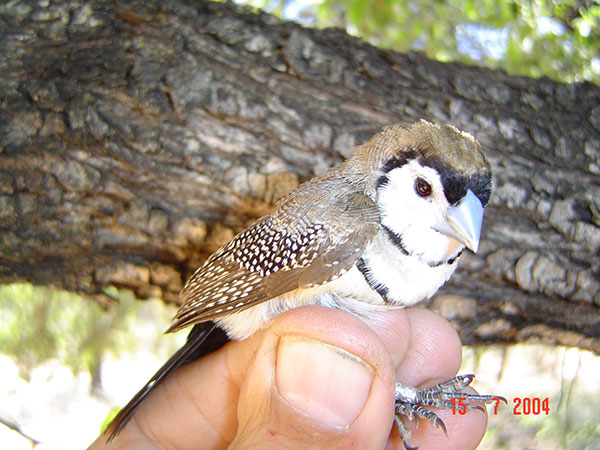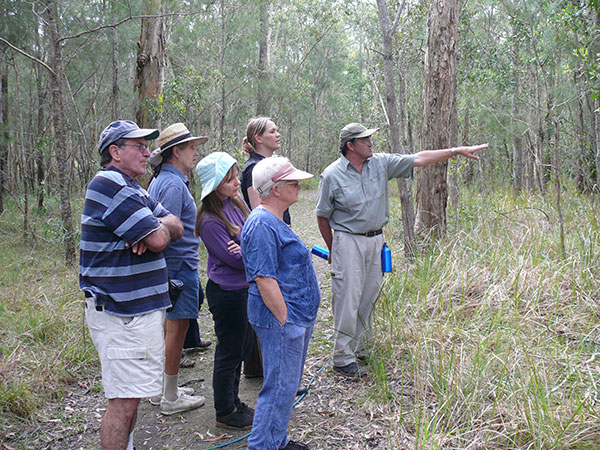Our 10 acre property in the Mount Cotton area is made up of 3 distinct zones, namely the garden area of around 1 acre, a treed field of about 2 acres and 6 acres composed of sclerophyll forest. It was this latter part of the property which attracted us as buyers 25 years ago when we were looking for a block with mature eucalyptus species and a well developed understorey as a site for a bird banding project under the Australian Bird and Bat banding Scheme.
Over 5,000 birds consisting of around 100 species have been banded on the property over the last 25 years. A special study was made of the Scarlet Honeyeater which winter in the area between March and October. Records indicate site fidelity with the same individuals returning year after year. This small bird can be long-lived with some individuals being over 10 years in age.
Our initial hopes that the field area would naturally regenerate proved optimistic and only wattles re-grew, hence we undertook some planting of Koala food trees in this area with limited success – the main difficulty being taking water to the saplings during prolonged dry spells. But some of the trees survived and we were speechless when about 15 years after planting we saw our first Koala in them – our plan had actually worked!
A good stand of Swamp Box (Lophostemon suaveolans) has also established in a section of the field (they are now 20+ years old and have circumferences up to 65 cm), but there is little tree species diversity in the field.
The 6 acres of forest at the back of the property is within the watershed of Native Dog Creek and is a beautiful area with a good diversity of plants gently shaded by some magnificent old Swamp Box trees over 2 metres in circumference.

The Blabers have been banding birds on their property for over 25 years. A Variegated Fairy Wren (header) and Double- barred Finch (above) are just 2 of the 100 species that have been banded. Note the tiny silver bands around the legs. Photos by Stephen Blaber.

Stephen Blaber points out some features of the Swamp Box bushland on his property during the Land for Wildlife Open Property Day in September 2008. Photo by Deborah Metters.
Yabby holes mark the flow of water during wet times and there are some Blackbutt Orchids in some of the trees and Hyacinth Orchids are common on the ground. Other groundcovers in this area include Star Goodenia, Fringed Lily, Kangaroo Grass and Blue Flax Lily. Trees include Tallowwood, Grey Ironbark, Red and Pink Bloodwoods,
“Records indicate site fidelity with the same individuals [Scarlet Honeyeaters] returning year after year.”
Swamp Box and Broad-leaved Paperbark. Resident animals include bandicoots, echidnas, wallabies, carpet snakes, possums and goannas.
There are a few problems in this area, the most significant being a patch of lantana in a previously cleared area. This has been spreading at a steady pace. We aim to control rather than eradicate this pest as it is very popular with wrens. Groundsel was a pest in this area in the past, but this is no longer the case. We hand-weed Singapore Daisy which is rampant on the neighbouring block as well as some Ageratum. There are also a few Camphor Laurels (left as the fruit are favoured by White-headed Pigeons).
The wildlife of the area has been a great source of fascination and interest over the years. Some of the things we’ve enjoyed about living here has been the resident pair of Crested Hawks. We once had the mixed pleasure of seeing one of them come down and take a day old domestic chick which had escaped from a pen on the front lawn.
Another favourite bird is the Owlet Nightjar. We’ve had many carpet snake stories over the years, but one of the favourites was finding a seven footer on the front veranda draped over a bicycle drying itself after shedding its skin. Last October we had hundreds of butterflies in a section of the forest for around a week forming a moving cloud around you when you walked.
The wildlife has been a great source of interest and fascination over the years. The rewards of a natural environment are enormous and requires little intervention on our part apart from weed control. Fingers crossed for an effective biological control of lantana!
Article by Stephen and Tessa Blaber Land for Wildlife members, Logan City Council
